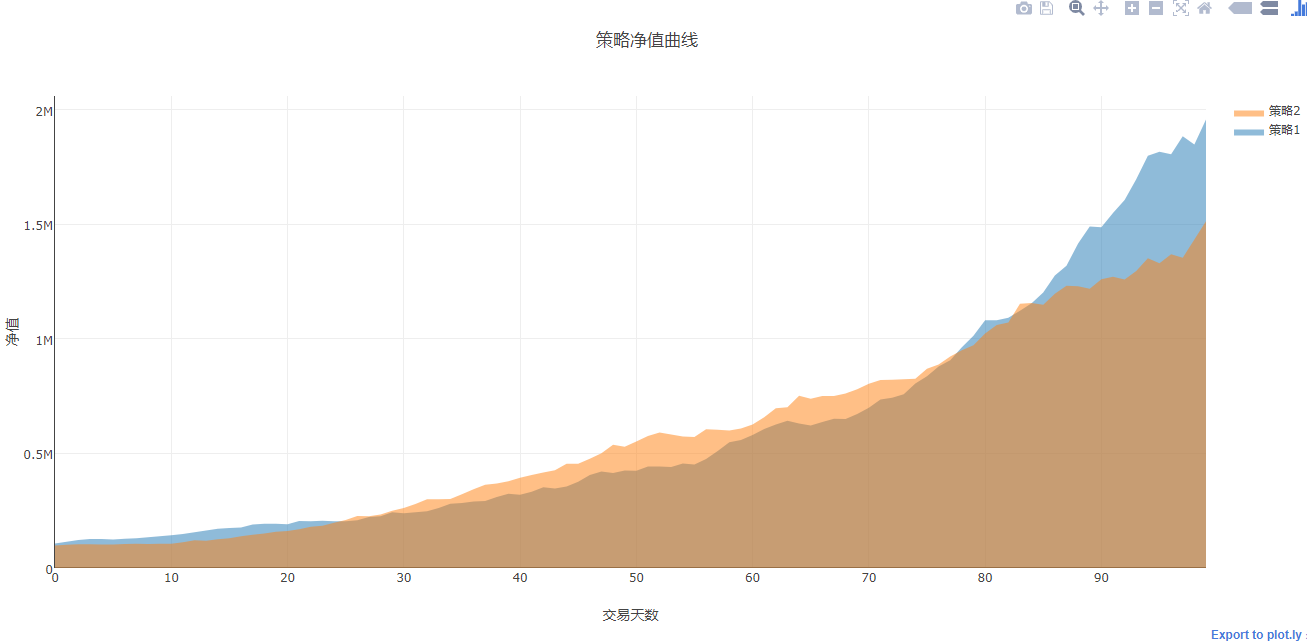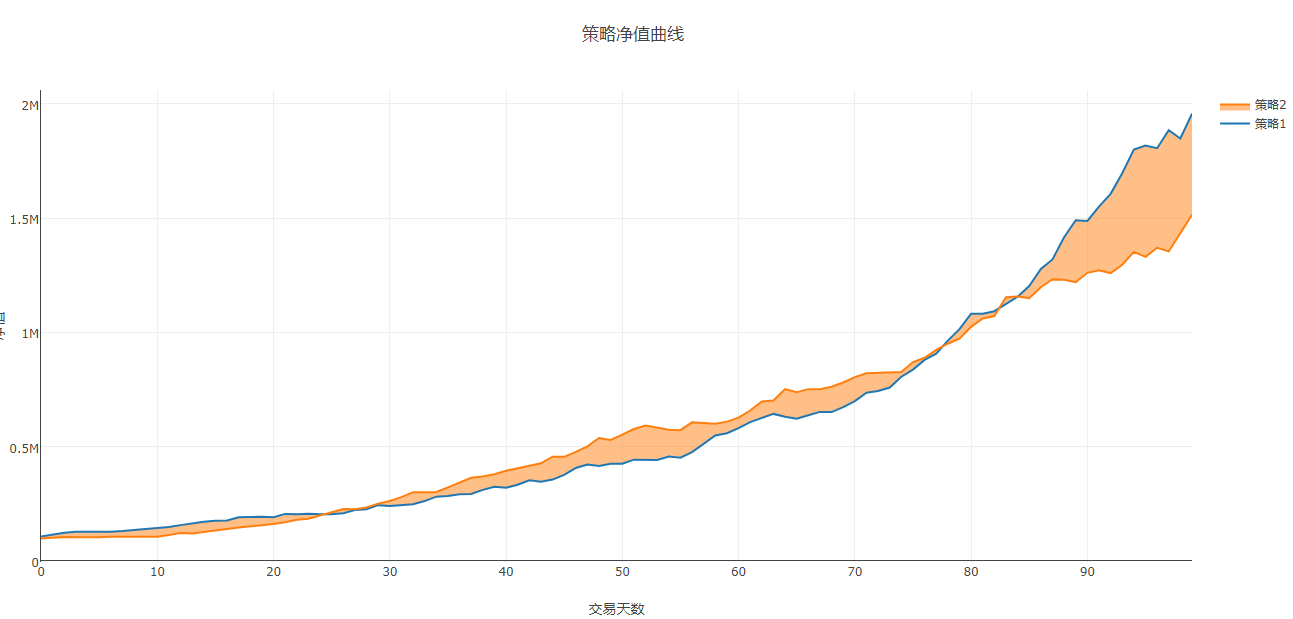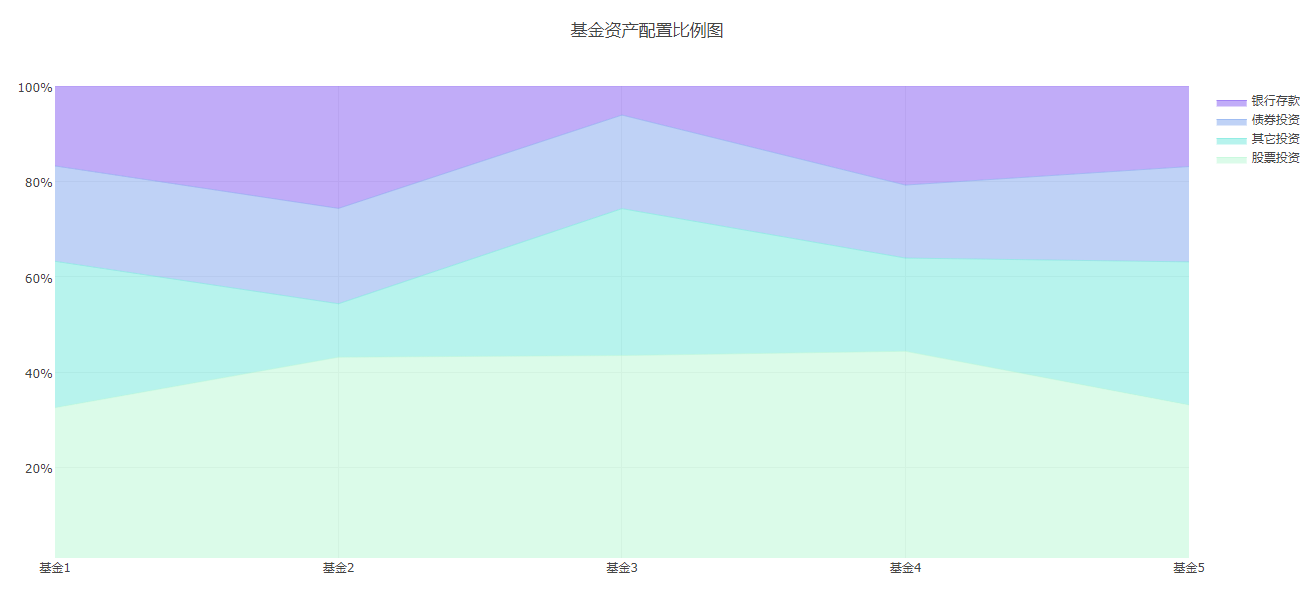今天我们来讲一下如何使用Python使用Plotly绘图工具,绘制面积图
绘制面积图与绘制散点图和折线图的画法类似,使用plotly graph_objs
中的Scatter函数,不同之处在于面积图对fill属性的设置
也就是说,相当于是在折线图的基础上,对图形进行填充
import plotly as py import plotly.graph_objs as go import numpy as np pyplt = py.offline.plot # 随机生成100个交易日的收益率 s1 = np.random.RandomState(8) # 定义局部种子 s2 = np.random.RandomState(9) # 定义局部种子 rd1 = s1.rand(100)/10 - 0.02 rd2 = s2.rand(100)/10 - 0.02 # 设定初始资金 initial1 = 100000 initial2 = 100000 total1 = [] total2 = [] for i in range(len(rd1)): initial1 = initial1*rd1[i] + initial1 initial2 = initial2*rd2[i] + initial2 total1.append(initial1) total2.append(initial2) trace1 = go.Scatter( # x = [1, 2, 3, 4], y = total1, fill = 'tonexty', mode= 'none', # 无边界线 name = "策略1" ) trace2 = go.Scatter( # x = [1, 2, 3, 4], y = total2, fill = 'tozeroy', mode= 'none',# 无边界线 name = "策略2" ) data = [trace1, trace2] layout = dict(title = '策略净值曲线', xaxis = dict(title = '交易天数'), yaxis = dict(title = '净值'), ) fig = dict(data = data, layout = layout) pyplt(fig, filename='tmp/1.html')

运行如上代码,会得到如上图所示的图形面积图
展示了两个不同的交易策略的净值曲线图,数据是随机生成的
就相当于做了折线图后,进行了填充得到
我们在来说一下内部填充面积图
内部填充面积图是仅仅填充两条曲线交叉所形成的面积部分,同样设置fill属性来完成。
只需要在原来的面积图上设置第一条曲线无填充效果即可
下面我们来看看代码
import plotly as py import plotly.graph_objs as go import numpy as np pyplt = py.offline.plot # 随机生成100个交易日的收益率 s1 = np.random.RandomState(8) # 定义局部种子 s2 = np.random.RandomState(9) # 定义局部种子 rd1 = s1.rand(100)/10 - 0.02 rd2 = s2.rand(100)/10 - 0.02 # 设定初始资金 initial1 = 100000 initial2 = 100000 total1 = [] total2 = [] for i in range(len(rd1)): initial1 = initial1*rd1[i] + initial1 initial2 = initial2*rd2[i] + initial2 total1.append(initial1) total2.append(initial2) trace1 = go.Scatter( y = total1, fill = None, mode= 'lines', # 无边界线 name = "策略1" ) trace2 = go.Scatter( # x = [1, 2, 3, 4], y = total2, fill = 'tonexty', mode= 'lines',# 无边界线 name = "策略2" ) data = [trace1, trace2] layout = dict(title = '策略净值曲线', xaxis = dict(title = '交易天数'), yaxis = dict(title = '净值'), ) fig = dict(data = data, layout = layout) pyplt(fig, filename='tmp/1.html')

运行上诉代码,我们可以得到如上图所示的内部填充面积图
我们设置了fill = None,
在设置第二条曲线的填充的效果为tonexty
即fill = 'tonexty' 即可得到如上图所示的图例
接下来我们讲解一下堆积面积图
堆积面积图与之前我写的博客中,层叠柱状图类似
都是展示了数据累加的效果
不同之处在于对数据的设置
import plotly as py import plotly.graph_objs as go data_1 = go.Scatter( x = ['基金1', '基金2', '基金3', '基金4','基金5'], y = [32.52, 43.12, 43.47, 44.36, 33.11], name = '股票投资', mode = 'lines', line = dict(width=0.5, color = 'rgb(184, 247, 212)'), fill = 'tonexty' ) data_2 = go.Scatter( x = ['基金1', '基金2', '基金3', '基金4','基金5'], y = [63.24, 54.33, 74.28, 63.91, 63.11], name = '其它投资', mode = 'lines', line = dict(width=0.5, color = 'rgb(111, 231, 219)'), fill = 'tonexty' ) data_3 = go.Scatter( x = ['基金1', '基金2', '基金3', '基金4','基金5'], y = [83.24, 74.33, 93.91, 79.22, 83.11], name='债券投资', mode='lines', line=dict(width=0.5, color='rgb(127, 166, 238)'), fill='tonexty' ) data_4 = go.Scatter( x = ['基金1', '基金2', '基金3', '基金4','基金5'], y = [100, 100, 100, 100, 100], name='银行存款', mode='lines', line=dict(width=0.5, color='rgb(131, 90, 241)'), fill='tonexty' ) data = [data_1, data_2, data_3, data_4] layout = go.Layout( title = '基金资产配置比例图', showlegend = True, xaxis = dict( type = 'category', ), yaxis = dict( type = 'linear', range = [1, 100], dtick = 20, ticksuffix = '%' ) ) pyplt = py.offline.plot fig = go.Figure(data = data, layout = layout) pyplt(fig, filename = 'tmp/stacked-area-plot.html')

可以看到,运行上诉代码,可以得到如上图所示的堆积面积图图例
注意的是,在绘制层叠柱状图时需要设置stack模式,而绘制堆积面积图时则不需要
这就是堆积面积图需要累加数据的原因
在本质上,堆积面积图的堆积效果是在同一个图形中绘制对个面积图来实现
今天就讲到这里,谢谢大家阅读,感谢支持!谢谢点赞